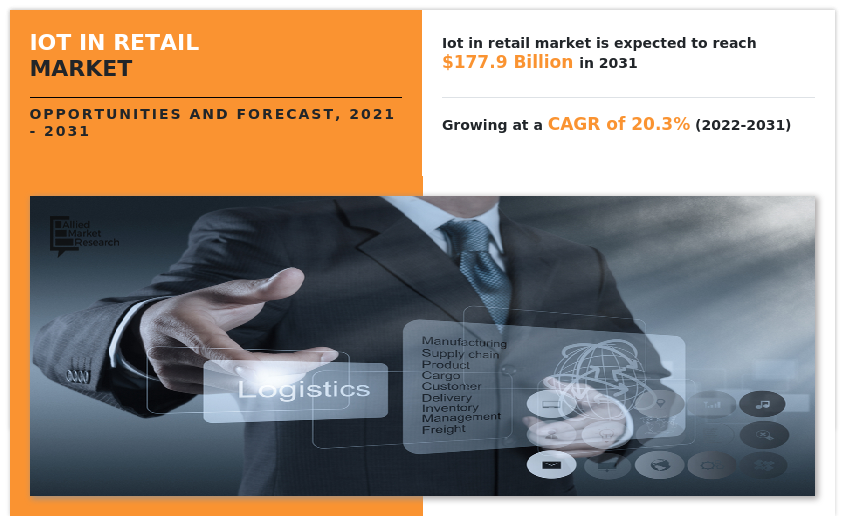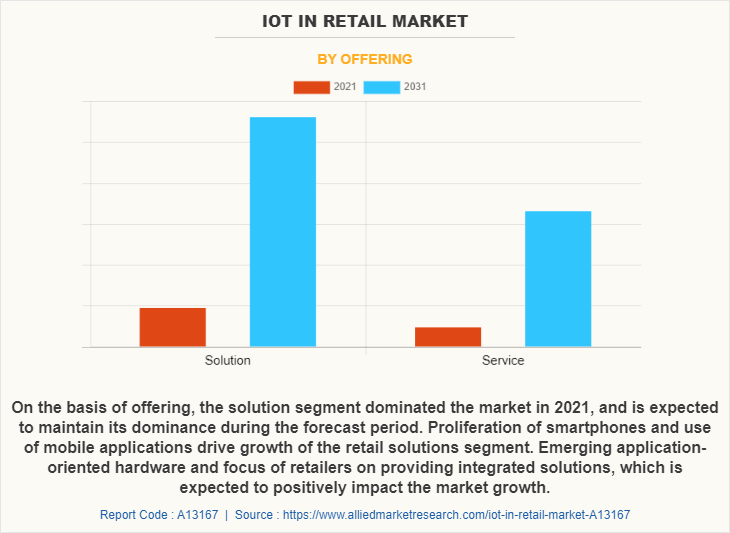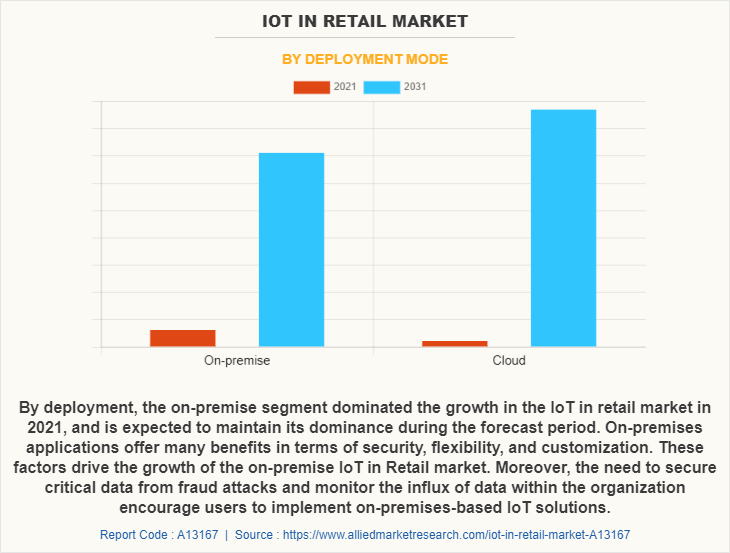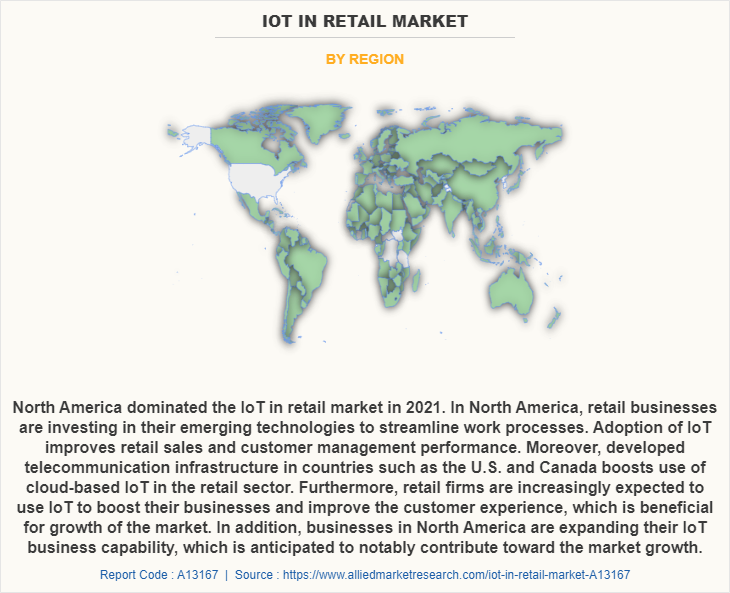IoT In Retail Market Research, 2031
The global iot in retail market size was valued at $28.14 billion in 2021, and is projected to reach $177.90 billion by 2031, growing at a CAGR of 20.3% from 2022 to 2031.
Factors such as effective store space monitoring, inventory management, supply chain management, and customer behavior monitoring drive demand for internet of things (IoT) in the retail market. Moreover, optimizing and automating the supply chain is one of the main factors for IoT adoption among retailers. Connectivity technologies, including digital signage, top-of-the-shelf displays, beacons, and price displays, provide opportunities for a brand to access large volumes of data on customer activity during in-store shopping.

Internet of Things (IoT) describes the network of physical objects that are embedded with sensors, software, and other technologies for the purpose of connecting and exchanging data with other devices and systems over the internet. These devices range from ordinary household objects to sophisticated industrial tools. Over the past few years, IoT has become one of the most important technologies across the globe. IoT devices share the data that is collected by IoT sensors or other edge devices where data is sent to cloud server to be analyzed. These devices further communicate with other related devices and act on the information they get from one another. These devices do most of their work without human intervention, although people can interact with these devices.
Use of IoT in the retail industry is closely related to GPS and RFID technologies that help brands track products throughout the entire supply chain process. It gives retailers visibility they need to track product movement, conditions, and track location, as well as predict an exact delivery time.
Retailers are using IoT technology to improve customer experience, reduce costs, drive growth, and improve the overall performance. IoT sensors connected to a device allow retailers to collect customer feedback after the shopping experience. This data provides real-time customer satisfaction insights that can improve in-store customer experience. Use of IoT sensors by retailers monitors goods throughout the whole supply chain. Retailers are using IoT technology to keep track of lost shopping carts and baskets. Tracking these assets can help stores lower the cost of having to replace them. By placing sensors on assets, such as shopping carts and baskets, retailers will be able to track them to their exact location and receive status updates and alerts whether or not they are damaged.
However, data security & privacy concerns and high implementation & maintenance cost of IoT devices restrain growth of the market globally. On the contrary, reduction in cost of connected devices and IoT traction among SMEs is expected to create lucrative opportunities for expansion of the IoT in retail market globally.
Top Impacting Factors
Factors such as growth in demand for IoT solutions, increase in cloud platform for deployment of IoT, and increase in adoption of smart payment solutions impact growth of the IoT market globally. In addition, the market growth is affected by data security & privacy concerns and high implementation & maintenance cost of IoT devices. Furthermore, increase in use of IoT among SMEs influences the market growth. However, each of these factors is anticipated to have a definite impact on growth of the global IoT market during the forecast period.
Growth in demand for IoT solutions
Customer expectations are constantly evolving with emerging IoT technologies such as sensors and RFID in retail, and so businesses are investing in digital transformation in an attempt to continue to meet customer expectations. Digital transformation is all about implementing and adopting IoT enabled automation technologies for better business operations and decision making. IoT in retail solutions are one of the most sought digital technologies by enterprises for better efficiency and utilize their IT systems to cater to dynamic requirements of customers. For instance, as per the International Data Corporation (IDC), 75% organizations will have digital transformation implementation roadmaps by 2023, up from 27% registered in 2020.
Rapid increase in mobile banking
The increased use of smartphones for payments is a significant factor that drives the growth of IoT in Retail solutions, particularly in emerging markets. The loss or theft of mobile phones often hold payment credentials obtained and provide relatively easy access to personally identifiable information such as email address, home address, and banking & stored payment information. Fraud prevention solutions typically monitor the aspects of the transaction such as device identification, location, and network.
Increase in cloud platform for deployment of IoT
Cloud computing is an emerging technology, which allows retail enterprises to access and store data online. Agility, scalability, reliability, and flexibility are some of the major characteristics associated with cloud technology. Software-as-a-service (SaaS) or on-demand are some of the cloud computing service models, wherein users pay as per their usage. Cloud-based applications reduce IT infrastructure cost of a retail organizations to some extent. This is the prime reason behind increased adoption of cloud-based applications among companies. With mobiles becoming an integral part of individuals, enterprises are spending on cloud-connected mobile application for easy accessibility to information anytime and anywhere. In addition, cloud-connected mobile applications allow individuals to synchronize, update, and control information.
Furthermore, adoption of cloud and mobile-enabled IoT is expected to rise in the future, which, in turn, is likely to propel the IoT in retail market growth. In addition, IoT devices generate massive volume of data per second. Cloud computing helps in storage and analysis of this data so that retail enterprise can get maximum benefit of an IoT infrastructure.
Segment Review
The IoT in retail industry is segmented on the basis of offering, organization size, deployment, application, and region. On the basis of offering, the market is segmented into solutions and services. Depending on solutions, the market is segmented into hardware and platforms. Depending on platforms, the market is segmented into device management, application management, and connectivity management.
According to organization size, it is fragmented into large enterprises and SMEs. On the basis of deployment, the market is segmented into cloud and on-premise. Depending on application, the market is segregated into supply chain operations management, customer management, sales & customer management, asset management, and others. Region wise, it is analyzed across North America, Europe, Asia-Pacific, and LAMEA.
Some of the key IoT in retail market industry players profiled in the report include are Cisco System, Inc., International Business Machine Corporation, Intel Corporation, Microsoft Corporation, PTC, Huawei technologies Co. Ltd., Sierra Wireless, Amazon Web Service (AWS), SAP SE, Software AG, Bosch.IO GmbH, Google LLC., NEC Corporation, Oracle Corporation, AT&T Intellectual Property, Vodafone Idea limited, and Happiest Minds. This study includes market trends, IoT in retail market analysis, and future estimations to determine the imminent investment pockets.
On the basis of offering, the solution segment dominated the IoT in retail market share in 2021, and is expected to maintain its dominance during the forecast period. Proliferation of smartphones and use of mobile applications drive growth of the retail solutions segment. Emerging application-oriented hardware and focus of retailers on providing integrated solutions, which is expected to positively impact the market growth.
However, services segment registered highest growth rate during the forecast period. Services related to IoT in retail provides services for IoT technology for various strategies and these strategies ensure smooth running and troubleshooting of any glitches within the solutions. These services associated IoT technologies help in gaining knowledge of technologies, which propel expansion of IoT services in the retail sector.

By deployment, the on-premise segment dominated the growth in the IoT in retail industry in 2021, and is expected to maintain its dominance during the forecast period. On-premises applications offer many benefits in terms of security, flexibility, and customization. These factors drive the growth of the on-premise IoT in Retail market. Moreover, the need to secure critical data from fraud attacks and monitor the influx of data within the organization encourage users to implement on-premises-based IoT solutions.
However, cloud segment registered highest growth rate during the forecast period. Cloud-based IoT in retail software has low capital expenditure as well as low maintenance requirements and is, therefore, highly preferred by mid-sized financial institutions. Growth in adoption of cloud-based IoT in retail software among large and medium-sized enterprises mainly drives the market growth.

By organizational size, large enterprise segment dominated the growth in the IoT in Retail market in 2021, and is expected to maintain its dominance during the forecast period. Increase has been witnessed in adoption of IoT technology across large retail organizations, owing to rapid expansion of business and surge in need for real-time data analytics, which lead to high competition. Organizations must plan in advance, strategize about time-to-market, predictive maintenance, and production management. Thus, increase in adoption of connected devices and edge computing in large enterprises to operate seamless machining operations, which notably contributes toward the market growth.
However, small & medium sized enterprises (SME’s) segment is anticipated to register the highest growth rate during the forecast period. Adoption of IoT in retail solutions helps SMEs integrate with the global market by helping them gain better and faster business insights to support real-time decision-making and capitalize on future opportunities. It contributes toward the market growth by helping to streamline business processes, increase business efficiency, and reduces business downtime. Moreover, adoption of cloud based IoT in retail tools is providing ample growth opportunities for SMEs in IoT in retail market.
By application, supply chain operations management segment dominated the growth in the IoT in retail market in 2021, and is expected to maintain its dominance during the forecast period. IoT (Internet of Things) enables retailers to drive innovation in their supply chains to reduce costs and improve customer services. Leading tech companies and retailers are collaborating on multiple fronts. Packing products into bags with automatic sensors to monitor weight, humidity, temperature, and shock to prevent product damage, significantly reducing possibility of returns and associated costs.
In addition, diagnosing problems remotely can turn into a win-win situation for both customers and retailers. This also enables customers to derive greater value from their purchase and helps retailers save costs and reduce burden on their supply chain. Moreover, IoT also helps to track fleet transportation and product transportation, giving great control over logistics management and helps to enhance customer satisfaction. All these benefits drive the IoT in retail market for supply chain operations.
However, customer management segment is expected to register the highest growth rate during the forecast period. Customer management simplifies process of communicating with customer and increase their satisfaction about services or products. It not only contains direction and guidelines about how to direct interactions take place between customer and enterprise, but is also used for organizing and tracking all relevant information. This information is needed to find leads, close deals and retain customers, increase sales, build stronger relationships, create more personalized customer services, and make processes more efficient and simplified. Customer management helps retail sales teams to automate their sales activities and track performance of teams. All these benefits of IoT in customer management drives the IoT in retail market.
North America dominated the Internet of Things in Retail Market in 2021. In North America, retail businesses are investing in their emerging technologies to streamline work processes. Adoption of IoT improves retail sales and customer management performance. Moreover, developed telecommunication infrastructure in countries such as the U.S. and Canada boosts use of cloud-based IoT in the retail sector. Furthermore, retail firms are increasingly expected to use IoT to boost their businesses and improve the customer experience, which is beneficial for growth of the market.
In addition, businesses in North America are expanding their IoT business capability, which is anticipated to notably contribute toward the market growth. However, Asia-Pacific is expected to witness highest growth rate during the forecast period. In Asia-Pacific, the IoT in retail market growth is expected to be driven by numerous economic and process benefits such as real-time data analytics, network management, and industrial automation. Moreover, increased demand for smartphones and other connected devices as well as surge in need for of internet access are some of the major factors driving the IoT in retail market growth.

COVID-19 Impact Analysis
The current estimation of 2030 is projected to be higher than pre-COVID-19 estimates. The internet of things in retail market is expected to grow rapidly after the pandemic, owing to rise in adoption of work-from-home culture across the globe.COVID-19 has disrupted normal life and has enforced a substantial change in the policies, priorities, and activities of individuals, organizations, and governments. These changes are proving to be a catalyst for technology and innovation. IoT platforms revenue will reach $66 billion in 2020, a 20% increase over last year’s figure. Increase in revenue will indicate that use of IoT has overcome the negative impact on supply chain due to COVID-19 lockdown.
Moreover, during the COVID due to WFH policies the demand for cloud-based solutions and the SaaS-based model increased significantly. This has positively impacted the market growth. Incidentally, during the pandemic, IoT in retail and automation helped eliminate the dependency on staff availability, thus supporting both remote working and ensuring business resilience.
Key Benefits For Stakeholders
- This report provides a quantitative analysis of the IoT in retail market forecast, current trends, estimations, and dynamics of the iot in retail market analysis from 2021 to 2031 to identify the prevailing iot in retail market opportunities.
- The market research is offered along with information related to key drivers, restraints, and opportunities.
- Porter's five forces analysis highlights the potency of buyers and suppliers to enable stakeholders make profit-oriented business decisions and strengthen their supplier-buyer network.
- In-depth analysis of the iot in retail market segmentation assists to determine the prevailing market opportunities.
- Major countries in each region are mapped according to their revenue contribution to the global market.
- Market player positioning facilitates benchmarking and provides a clear understanding of the present position of the market players.
- The report includes the analysis of the regional as well as global iot in retail market trends, key players, market segments, application areas, and market growth strategies.
IoT in Retail Market Report Highlights
| Aspects | Details |
| By Offering |
|
| By Application |
|
| By Deployment Mode |
|
| By Enterprise Size |
|
| By Region |
|
| Key Market Players | AT&T Intellectual Property, NEC Corporation, Intel Corporation, Happiest Minds, Software AG, Google LLC, Vodafone Idea Limited, Microsoft Corporation, Cisco System, Inc., Amazon Web Service (AWS), SAP SE, Oracle Corporation, PTC, Huawei technologies Co. Ltd., International Business Machine Corporation, Bosch.IO GmbH |
Analyst Review
In accordance with insights by CXOs of leading companies, the global IoT in retail market is projected to witness prominent growth, especially in Asia-Pacific and North America. This growth is attributed to increased investments by organizations and governments for automation and adoption of cloud-based IoT in retail solutions. In addition, adoption of IoT-based devices globally provides ample growth opportunities for IoT in retail solutions.
The current business scenario has witnessed increase in adoption of IoT in retail solutions in developed as well as developing regions as IoT solutions in retail maximizes business efficiency by minimizing operational efforts with faster processing times and lower labor costs, enhancing its adoption in the IoT in retail market.
Moreover, retail businesses are becoming more inclined toward use of IoT technology to increase revenue, reduce costs, improve efficiency, and provide customers with a better experience. IoT has transformed retail and ecommerce industries, including logistics, inventory and supply chain management, as well as end customers. Many things have become easier and better due to adoption of IoT in retail sector. IoT in retail has helped stores to make better decisions, collect and analyze data, automate workflows, and more. IoT adoption has become even more vital due to changing lifestyles and ever-evolving corporate environments.
In retail and e-commerce, IoT is becoming more and more popular, owing to numerous benefits it brings to the industry. Technology helps analyze customer behavior, develop new business models, and optimize productivity.
Moreover, enterprises make significant investments in R&D to enhance their existing solutions and deliver new solutions as well as develop new machine intelligence and automation technologies. For instance, in February 2019, IBM invested $ 2 billion in its new research hub for artificial intelligence (AI) in New York. This investment is expected to enhance its efforts to enhance growth from emerging technologies by transforming business operations benefitting the IoT in retail market.
Prominent market players are exploring new technologies and platforms to meet increase in customer demands. Product launches, partnerships, and acquisitions are expected to enable them to expand their product portfolios and penetrate different regions. For instance, in January 2022, Google partnered with NCR, a leading enterprise technology provider. Through this partnership it intends to boost cloud-driven transformation in retail.
Asia-Pacific exhibits the highest adoption of IoT in retail solutions. On the other hand, LAMEA is expected to grow at a significant growth rate, predicting a lucrative market growth for IoT in retail solutions, especially in countries such as Brazil, South Africa, and Argentina.
Factors such as effective store space monitoring, inventory management, supply chain management, and customer behavior monitoring drive demand for internet of things (IoT) in the retail market.
North America dominated the IoT in retail market in 2021. In North America, retail businesses are investing in their emerging technologies to streamline work processes. Adoption of IoT improves retail sales and customer management performance.
The global IoT in retail market was valued at $28,139.87 million in 2021, and is projected to reach $177,899.02 million by 2031, registering a CAGR of 20.3% from 2022 to 2031.
The IoT in retail market is dominated by key players such as Cisco System, Inc., International Business Machine Corporation, Intel Corporation, Microsoft Corporation, PTC, Huawei technologies Co. Ltd., Sierra Wireless, Amazon Web Service (AWS), SAP SE, Software AG, Bosch.IO GmbH, Google LLC., NEC Corporation, Oracle Corporation, AT&T Intellectual Property, Vodafone Idea limited, and Happiest Minds.
Loading Table Of Content...



